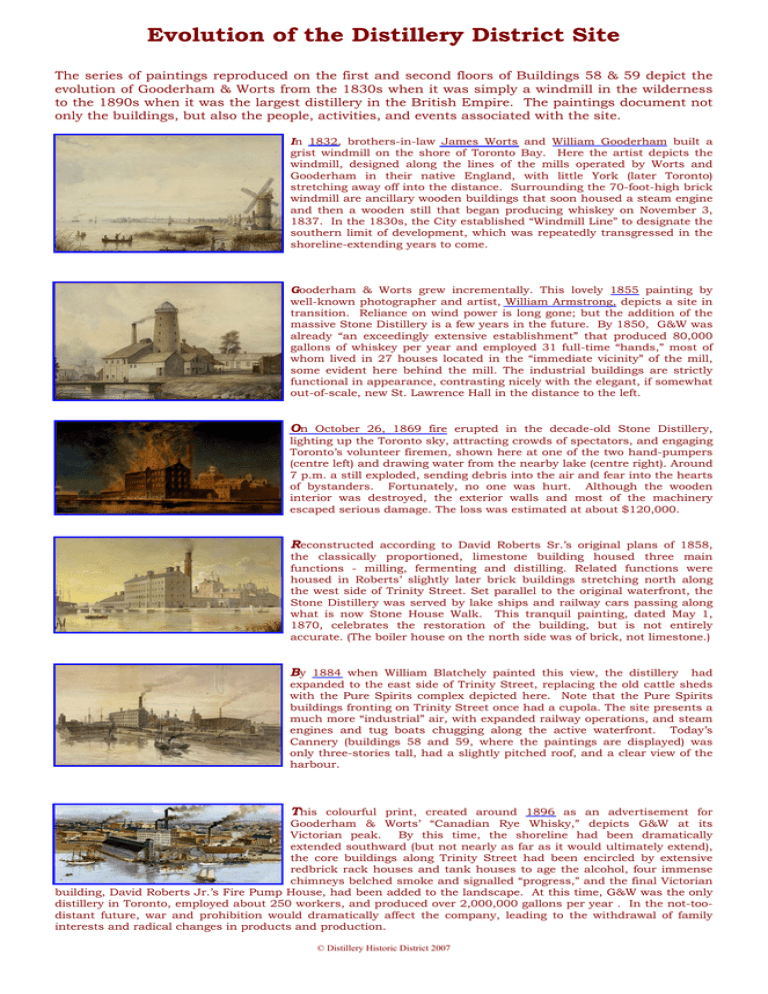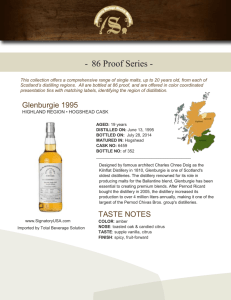Evolution of the Distillery District Site
advertisement

Evolution of the Distillery District Site The series of paintings reproduced on the first and second floors of Buildings 58 & 59 depict the evolution of Gooderham & Worts from the 1830s when it was simply a windmill in the wilderness to the 1890s when it was the largest distillery in the British Empire. The paintings document not only the buildings, but also the people, activities, and events associated with the site. In 1832, brothers-in-law James Worts and William Gooderham built a grist windmill on the shore of Toronto Bay. Here the artist depicts the windmill, designed along the lines of the mills operated by Worts and Gooderham in their native England, with little York (later Toronto) stretching away off into the distance. Surrounding the 70-foot-high brick windmill are ancillary wooden buildings that soon housed a steam engine and then a wooden still that began producing whiskey on November 3, 1837. In the 1830s, the City established “Windmill Line” to designate the southern limit of development, which was repeatedly transgressed in the shoreline-extending years to come. Gooderham & Worts grew incrementally. This lovely 1855 painting by well-known photographer and artist, William Armstrong, depicts a site in transition. Reliance on wind power is long gone; but the addition of the massive Stone Distillery is a few years in the future. By 1850, G&W was already “an exceedingly extensive establishment” that produced 80,000 gallons of whiskey per year and employed 31 full-time “hands,” most of whom lived in 27 houses located in the “immediate vicinity” of the mill, some evident here behind the mill. The industrial buildings are strictly functional in appearance, contrasting nicely with the elegant, if somewhat out-of-scale, new St. Lawrence Hall in the distance to the left. On October 26, 1869 fire erupted in the decade-old Stone Distillery, lighting up the Toronto sky, attracting crowds of spectators, and engaging Toronto’s volunteer firemen, shown here at one of the two hand-pumpers (centre left) and drawing water from the nearby lake (centre right). Around 7 p.m. a still exploded, sending debris into the air and fear into the hearts of bystanders. Fortunately, no one was hurt. Although the wooden interior was destroyed, the exterior walls and most of the machinery escaped serious damage. The loss was estimated at about $120,000. Reconstructed according to David Roberts Sr.’s original plans of 1858, the classically proportioned, limestone building housed three main functions - milling, fermenting and distilling. Related functions were housed in Roberts’ slightly later brick buildings stretching north along the west side of Trinity Street. Set parallel to the original waterfront, the Stone Distillery was served by lake ships and railway cars passing along what is now Stone House Walk. This tranquil painting, dated May 1, 1870, celebrates the restoration of the building, but is not entirely accurate. (The boiler house on the north side was of brick, not limestone.) By 1884 when William Blatchely painted this view, the distillery had expanded to the east side of Trinity Street, replacing the old cattle sheds with the Pure Spirits complex depicted here. Note that the Pure Spirits buildings fronting on Trinity Street once had a cupola. The site presents a much more “industrial” air, with expanded railway operations, and steam engines and tug boats chugging along the active waterfront. Today’s Cannery (buildings 58 and 59, where the paintings are displayed) was only three-stories tall, had a slightly pitched roof, and a clear view of the harbour. This colourful print, created around 1896 as an advertisement for Gooderham & Worts’ “Canadian Rye Whisky,” depicts G&W at its Victorian peak. By this time, the shoreline had been dramatically extended southward (but not nearly as far as it would ultimately extend), the core buildings along Trinity Street had been encircled by extensive redbrick rack houses and tank houses to age the alcohol, four immense chimneys belched smoke and signalled “progress,” and the final Victorian building, David Roberts Jr.’s Fire Pump House, had been added to the landscape. At this time, G&W was the only distillery in Toronto, employed about 250 workers, and produced over 2,000,000 gallons per year . In the not-toodistant future, war and prohibition would dramatically affect the company, leading to the withdrawal of family interests and radical changes in products and production. © Distillery Historic District 2007



